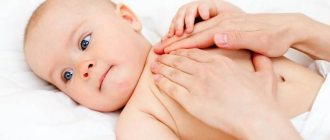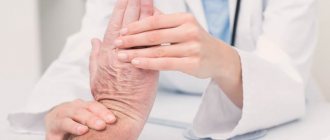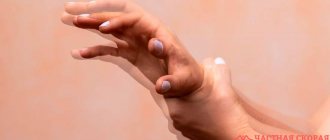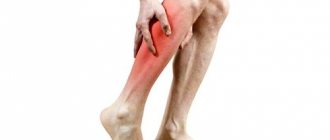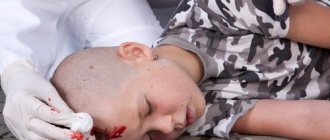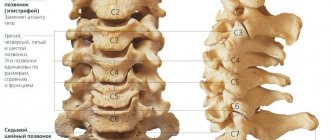Tremor in newborn babies is manifested mainly by twitching of the chin and upper limbs. It can be considered a similar manifestation of muscle hypertonicity, which is the main sign of an immature nervous system of a baby. Tremor in infants manifests itself mainly due to overexcitability of the nervous system when the baby screams, cries, and also when he wants to eat, or someone frightened him. Parents may also notice that their child's eyeballs move during sleep. This usually occurs during a phase of sleep called REM sleep.
Tremor in newborns is not a rare phenomenon; it occurs in almost 50% of all children born. From the first day of life until 4 months, signs of tremor are considered normal, but if they do not disappear after this period, then you need to take a closer look at the baby. It may be worth consulting a doctor at this point. But if the hands and chin have not stopped shaking even after a year, then this is a clear signal about problems with the child’s health. To understand when tremor is a benign specific condition of the nervous system, and when it is a serious problem, we suggest that you read this article.
The children's nervous system lends itself well to “regulation”. Therefore, the sooner you notice the problem and receive qualified help, the greater the chances of normalizing the state of the central nervous system and restoring it.
What is most affected by involuntary shaking in children?
If you look at the statistics, you can make an unambiguous conclusion - often almost all babies have head tremors. This is what indicates the incomplete maturity of the baby’s nervous system. When a baby's arms or legs, as well as lips and chin, shake, this is already a consequence of prematurity.
Parents should also understand that such phenomena do not occur in every child. Therefore, you should not immediately panic while waiting for your baby.
Tremor in children: main causes
As mentioned above, the culprit may be the immaturity of the nervous system. But other factors, such as premature birth and fetal hypoxia, can also lead to trembling.
The child's immature nervous system
After birth, children do not yet have developed coordination of movements, and their nervous system has not reached the required stage of maturity. This is what most often causes chin tremor in infants, as well as trembling of the limbs. A violent outburst of emotions, which increases the level of norepinephrine in the body, also contributes to the appearance of trembling of the baby’s arms and legs. Increases the chances of developing this phenomenon and muscle hypertonicity.
Fetal hypoxia
Fetal hypoxia, which can develop both in utero and at the time of birth, has become a fairly common problem. Lack of oxygen, especially long-term, negatively affects brain function. A number of factors contribute to the development of hypoxia:
- Disorders of the functional activity of the placenta.
- An infection that developed in utero.
- Increased tone of the uterus when the mother is threatened with miscarriage.
- Bleeding during pregnancy.
- Polyhydramnios.
All these factors limit the supply of oxygen to all cells of the body, including the brain, which also affects the development of the nervous system. In addition, oxygen starvation can be caused by the characteristics of labor (rapid labor and weak contractions), entanglement of the fetus in the umbilical cord, and placental abruption.
Premature birth
Chin tremor in newborns born prematurely also occurs due to the immaturity of the nervous system, since the baby was deprived of continued intrauterine development. Therefore, the central nervous system of a premature baby continues to form outside of the baby’s presence in the womb, and these can hardly be called optimal conditions for this process. No matter how attentively and carefully the mother treats the baby, she is not able to provide him with the atmosphere that was in her stomach. Therefore, we can safely say that limb tremors in children in any case depend on the maturity of the nervous system.
Republican Children's Clinical Hospital
Currently, the number of convulsive conditions in children is increasing. Most often they are provoked by severe brain damage, genetic abnormalities, and metabolic disorders. These conditions require mandatory prescription of anticonvulsants and supervision of a pediatric neurologist.
Along with this, attacks are becoming more common in children, causing concern for parents, but not requiring medical correction. These are non-epileptic seizures associated with nonspecific reactions of the immature brain.
Fejerman syndrome is a benign non-epileptic spasm of infancy that is virtually indistinguishable in appearance from epileptic seizures such as infantile seizures or myoclonic seizures.
Fejerman syndrome is diagnosed on the basis of typical clinical manifestations in the form of short-term nods or winces, provided that there are no focal neurological symptoms and normal psychomotor development in children during infancy, and epileptiform changes in the EEG should not be recorded either during the convulsive episode or during the interictal period . Benign non-epileptic myoclonus of infancy usually occurs in the first year of life (usually at 6 months), coinciding with the age of onset of West epilepsy. Usually the attacks are short-lived (1-2 seconds), but longer episodes are possible, usually due to the occurrence of repeated attacks. Chaotic isolated movements may occur several times a day, but not necessarily daily. The motor component of attacks can be different. Some events are manifested by short tonic spasms of the limbs or neck, others by episodes of “trembling”, short shudders, nods. Movements are almost always symmetrical. It is typical that attacks occur while awake, more often with excitement, fear, and sometimes during defecation and urination, but in 15% of patients they can also occur during sleep.
The cause of Fejerman syndrome is unknown. According to Maydell (2001), the motor manifestations of the syndrome are physiological muscle spasms. According to Caraballo et al. (2009), an interesting feature of the majority of examined families of patients with Fejerman syndrome is the presence of at least one of the parents with a university education. Whether this matters remains to be seen in future studies.
The prognosis of Fejerman syndrome is favorable with complete recovery by two to three years of age (most often attacks stop in the second year of life). Psychospeech development disorders were not observed in any patient. The combination of Fejerman's syndrome with idiopathic focal epilepsy (both age-dependent conditions) may indicate the presence of a single mechanism of pathogenesis - a congenital disorder of brain maturation processes.
Manifestations of benign myoclonus of infancy should be distinguished primarily from infantile spasms and epileptic seizures, but other non-epileptic seizure conditions should also be remembered. These are dystonic phenomena characteristic of paroxysmal dyskinesias, Sandifer syndrome, paroxysmal torticollis, paroxysmal choreoathetosis. Trembling can occur with drug poisoning, infant seizures, and as part of benign tremor. Nodding and flinching should be distinguished from benign neonatal seizures and other epileptic seizures. Benign rotation of the eyeballs and changes in posture during fear and flinching may be similar to tonic stretching.
Taking into account the complaints of the parents, examination data, normal psychomotor development, the absence of focal symptoms in the neurological status, as well as unchanged age-related EEG, a diagnosis is made: benign non-epileptic myoclonus of infancy. It is recommended to refrain from prescribing long-term anticonvulsant therapy. Further observation of the children showed a gradual disappearance of these conditions. If a child experiences forced stretching, flinching, folding, pretentious postures, turning the head and eyes, it is necessary to consult a doctor to promptly determine the cause of these conditions and decide on treatment.
Nomerovskaya A.A., State Budgetary Institution of Healthcare of the Republic of Kazakhstan, Russian Children's Clinical Hospital "Psychoneurological Department"
Reply
Targeted treatment and its necessity
Based on the data available to doctors, we can say that the concern is caused by tremor that persists for 4 months. In this case, the shaking spreads to the baby’s legs and head, and the mother knows for sure that the baby is not shaking at certain moments (hunger, fear, etc.). Parents should understand that such a phenomenon may be a warning sign of the following problems:
- Hypomagnesemia.
- Increased blood sugar levels.
- Intracranial hemorrhage.
- Drug withdrawal or withdrawal syndrome.
- Hypoxia-ischemia of the brain.
- Increased intracranial pressure.
- Low calcium levels in the blood.
- Sepsis.
In these cases, the doctor will definitely prescribe you a full examination and appropriate treatment.
What can be done
When the baby's chin and limbs shake, and his lips tremble, frightened mothers forget what to do in this situation. Parents themselves experience stress and panic. In fact, preventive measures for muscle spasms are simple.
If your baby has been twitching his head and chin since birth, but most of the time he is calm and happy with life, you need to minimize the number of shocks. At the same time, keep in mind that the child experiences stress from negative and positive emotions. The task of parents is to create a harmonious, calm environment in the house, to protect the baby from provocateurs of an outburst of feelings of a different nature.
Proceed according to the following plan:
- Analyze to what everyday moments the baby reacts violently (cries, is very happy, is afraid) and why this happens. Perhaps the cause of stress is the presentation of a new toy, too strong emotions of the mother, loud laughter of parents or screams.
- Carry out daily hygiene procedures and get ready for a walk calmly. Take your time and don't stress yourself out first. If possible, minimize the number of nervous breakdowns and disputes with relatives. Remember that the mood of the family is transmitted to the baby.
- Do not breastfeed when your baby is excited. When breastfeeding, the mother transfers her hormones to the baby, including norepinephrine. Increased levels of this substance in the blood provoke nervous movements of the chin and head in infants.
- Create a daily routine and strictly follow the plan.
- Give your child a relaxing massage and exercises to relieve hypertension.
- Bathe with soothing herbs. Add decoctions of chamomile, string, and oregano to the water.
- After six months, if the tremors have not stopped, consult a doctor. A neurologist will make a diagnosis based on examination and hardware studies. If necessary, he will prescribe medications: Pantogam, Glycine, Mydocalm.
What is the treatment
If a child’s arms, legs or head are shaking, then treatment should be aimed not only at restoring the state of the nervous system, but also at health in general. That is why the mother must strictly follow the neurologist’s instructions and adhere to all recommendations. Most often, medications such as Glycine, Asparkam, etc. are prescribed. But only a pediatric neurologist can identify the exact cause of trembling limbs and prescribe medications. Therefore, self-medication is dangerous.
But the procedures that are necessarily prescribed for children suffering from tremors are simply necessary. First of all, this is massage, gymnastics and swimming.
Massage treatments for tremors
At home, giving a baby a massage is quite simple, and any mother can handle it. The main thing is to combine massage with constant conversations with the baby. The main movements of massage include kneading, stroking, rubbing and vibration. Usually the doctor himself gives an example of how you should do a massage. But you can also watch a special video below.
In the meantime, I would like to say that during the session your baby should feel as comfortable as possible, because all your actions are aimed specifically at strengthening the child’s nervous system. Therefore, it is worth remembering some rules:
- Ventilate the room well.
- Before the massage, be sure to remove your rings and bracelets so as not to scratch your baby. It is also a good idea to cut your nails.
- Rub your palms together and knead your hands.
- Massage should be done only when the child is active and in a good mood.
- If during the process the child’s mood worsens, then stop the session. The baby should calm down and become cheerful again.
- Do not bring your baby to the clinic for a massage. It’s better to hire a massage therapist and introduce him to the child so that he can get used to a stranger. Ideally, it is better to do the massage yourself in an atmosphere familiar to the baby.
- Nothing should irritate the child. It is better to eliminate loud music, bright lights and other external factors before the massage session.
- Be sociable and affectionate with your child. Songs, rhymes and funny jokes are the best accompaniments to any procedure.
- Do a massage half an hour before water treatments. This way you can provide your baby with even more “relaxation”.
Swimming and gymnastics
If you have not yet decided to send your baby to infant swimming, then you can carry out water procedures at home. If a child has tremors of the limbs, then it will be extremely useful for him to swim, even while in your arms. Let the baby have plenty of play with his hands and feet, and let the water in the bathroom be at the most comfortable temperature.
Gymnastics for a baby is also useful. There are a number of exercises that you can also do with your baby at home.
- Grab your baby's foot with one hand and tap the outside of his leg with the other. This exercise is called the “hammer” and is repeated on both legs alternately.
- Stroke your baby's arms and legs. Take the baby by the hand and, shaking it slightly, lower yourself from the shoulder to the wrist. This exercise should be performed on the legs and arms alternately.
- Stretch your baby's buttocks. To do this, place the baby on his tummy and just lightly tap his butt with your little fists.
Remember that tremors are a completely natural phenomenon and should not cause you to panic. But you must monitor your baby daily. Children under one year old continue to develop, so you need to not miss the moment when you, together with a specialist, can make any adjustments. Doctors note several critical periods in a baby’s life. These are 1, 3, 9 and 12 months. It is at this time that the nerve endings become very sensitive, and any deviation can cause pathologies. Therefore, the future health of your baby depends on your attention and participation.
Treatment methods
The treatment method for tremor of the arms, legs, and head in a child is aimed at restoring the health of the baby in general and the nervous system in particular.
The recommendations of a pediatric neurologist should be strictly followed.
Massage for tremors in infants
In addition, parents definitely need to create a pleasant, cozy and friendly environment around their baby, systematically massage their baby (it promotes relaxation), instill swimming skills (this is possible even in a home bath), and do therapeutic exercises with him.
Such efforts of parents will not be in vain.
The easiest way to master massage techniques for newborns (from the age of 5-6 weeks) at home. The pediatrician will definitely teach mom and dad basic massage movements, based on which you can then proceed to perform a variety of exercises.
The basic massage movements are:
- vibration;
- kneading;
- trituration;
- stroking.
The basic rule is that all massage movements are performed from the periphery to the center (along the joints).
An important role is played by the baby’s psychological mood and his physical comfort during the massage:
- The room needs to be ventilated, this will take 20-30 minutes (if the weather is warm outside, then the massage can be performed with the window open);
- Hands must be dry, bracelets and rings must be removed, nails must be trimmed;
- Before starting the massage, you should shake your hands and rub your palms together so that they become warm;
- The massage session is carried out during the baby’s active waking hours; it is always necessary to ensure that he is in a good mood. If the mood deteriorates, you need to stop for a while, cheer up the child and you can continue;
- The place where the massage is performed should be familiar to the baby; it is convenient to do it on the changing table;
- Nothing should disturb the child, for example, the sun shining in his eyes;
- When doing a massage, it is useful to talk with the baby, smile, sing songs, it is better if the facial expressions are emotionally rich;
- Massage is always accompanied by stroking;
- There is no need to use aromatic oils or powder so as not to clog delicate pores (it is better to use regular products used for daily moisturizing for massage purposes);
- The highest effect of massage is observed before water procedures;
- Movements should be smooth. The massage begins with the face: in this case, it is necessary to stroke the baby along the edges and along the wings of the nose.
How tick-borne borreliosis manifests itself - symptoms and signs that will leave no doubt.
Is it possible for newborns to use the medicine Diacarb? We have collected reviews from doctors and patients, contraindications and indications for the medication in one review.
Basic exercises
Here are some basic exercises:
- "Hammer" . When the child is lying on his back, you need to clasp the right foot with one hand and tap the outside of the leg from bottom to top with the fist of the other. Next, the exercise is repeated with the foot of the other leg.
- “Stroking our hands . The baby's arm is fixed with the left hand, and the right hand gently clasps the shoulder. When lowering to the wrist, you should make shaking movements. Do the exercise 2-3 times and move on to the other hand. Using similar tactics, you can perform the “Stroking the Legs” exercise.
- "Watch" . Exercise also helps children with intestinal problems. The baby's tummy should be stroked clockwise for 5-7 minutes.
- "Toptyzhka" . The baby lies on his tummy, and the masseur gently kneads his buttocks with his fists. To keep your baby occupied, it is recommended to place a bright, interesting toy in front of him. He will look at her, reach for her, and thus the back and neck muscles will be activated.
- "Herringbone" . In the direction from the back to the coccyx and at an angle to the spine, it is necessary to make stroking movements.

